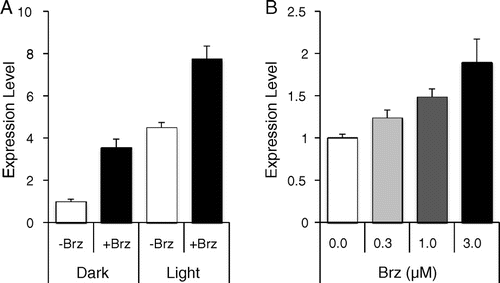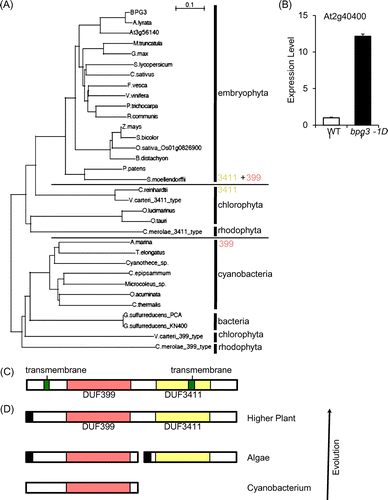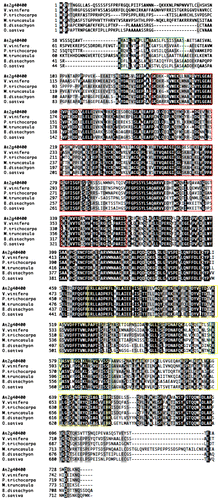Figures & data
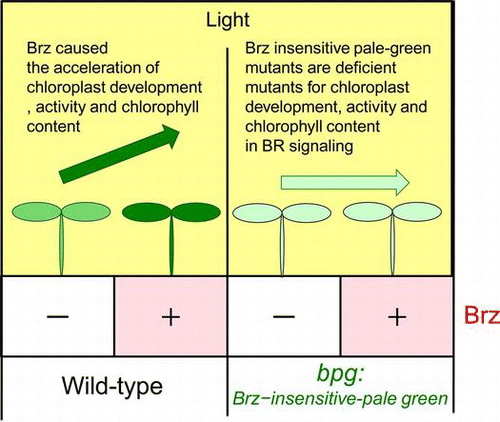
Fig. 1. Screening Strategy for the bpg (Brz-insensitive-pale green) mutants.
Notes: BR inhibitor Brz activated the chloroplast functions. Possible bpg mutants were disrupted in signaling from the BR-deficient condition to chloroplast activation. The BPG genes resulting from the mutants played important roles in chloroplast regulation for BR signaling.
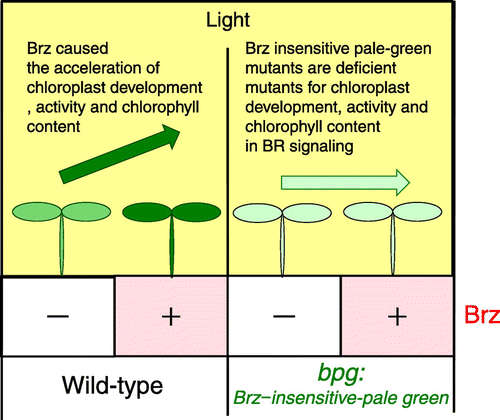
Fig. 2. Identification of the bpg3-1D mutant as a pale-green phenotype by the Brz treatment.
Notes: (A)–(D), Cotyledons of the wild-type ((A) and (B)) and bpg3-1D ((C) and (D)) grown on medium for 4 d without Brz ((A) and (C)) or with 1 µM Brz ((B) and (D)). Scale bars, 1 mm. (E)–(F), Endogenous contents of chlorophyll a (E) and chlorophyll b (F) in wild-type (WT) and bpg3-1D plants grown for 14 days without Brz or with 0.3 and 1 µM Brz under long days (16-h light/8-h dark). Error bars indicate SE (n = 3). (G)–(H), Wild-type (G), and bpg3-1D (H) plants grown on soil for 2 weeks. Scale bars, 10 mm. (I) Wild-type (WT), and bpg3-1D plants grown under long days (16-h light/8-h dark) on soil for 3 weeks. Scale bar, 5 cm.
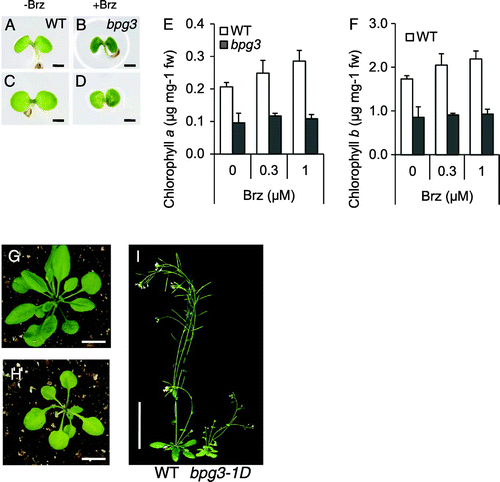
Fig. 4. Overexpression of BPG3 recaptured the pale-green phenotype of bpg3-1D.
Notes: (A) Quantitative real-time PCR analysis of BPG3 (At2g40400) mRNA expression in hypocotyls of the wild-type (WT) and BPG3-OX transformants. The BPG3 gene was overexpressed in the BPG3-OX mutant. The value was normalized against the expression of the ACT2 gene. Error bars indicate SD (n = 3). B-I, Cotyledons of wild-type ((B) and (C)), bpg3-1D ((D) and (E)), BPG3-OX1 ((F) and (G)) and BPG3-OX2 (H and I) plants grown on 1/2 MS medium for 5 d without Brz ((B), (D), (F), and (H)) or with 1 µM Brz ((C), (E), (G), and (I)) under long days (16-h light/8-h dark). Scale bars, 1 mm. (J)–(K), endogenous contents of chlorophyll a (J) and chlorophyll b (K) in wild-type (WT), bpg3-1D, BPG3-OX1 and BPG3-OX2 plants grown on medium for 14 d without Brz or with 0.3 and 1 µM Brz under long days (16-h light/8-h dark). The error bars indicate SE (n = 3). (L)–(O), Rosette leaf morphology of wild-type (L), bpg3-1D (M), BPG3-OX-1 (N), and BPG3-OX-2 (O) plants grown on soil for 3 weeks under long days (16-h light/8-h dark). Scale bars = 10 mm. (P)–(S), Cotyledons of wild-type ((P) and (Q)) and BPG3-KO ((R) and (S)) plants grown on 1/2 MS medium for 5 d without Brz ((P) and (R)) or with 1 µM Brz ((Q) and (S)) under long days (16-h light/8-h dark). Scale bars, 1 mm.
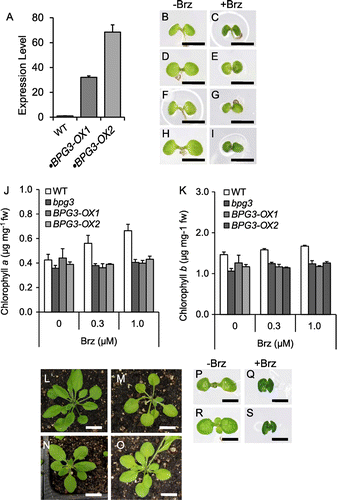
Fig. 5. BPG3 protein localized in the chloroplasts.
Notes: Confocal laser scanning microscopy of guard cells in 35S::BPG3-GFP transformants ((A)–(D)). The plants were grown for 14 d in the light on medium containing kanamycin. (A) Green fluorescence indicating BPG3-GFP localization in the guard cells. (B) Red autofluorescence of chlorophyll. (C) Bright-field images. (D) Merged image of (A)–(C). Scale bar, 10 µm.

Fig. 6. Expression of BPG3 mRNA is induced by Brz.
Notes: Quantitative real-time PCR analysis of BPG3 mRNA expression in the hypocotyls of wild-type plants treated with or without Brz grown under long days (16-h light/8-h dark) or in the dark. Error bars indicate SD (N = 3). (A) Wild-type plants treated with continuous stimulation for 7 d using 3 µM Brz. (B) Wild-type plants treated with transient stimulation for 3 h using 0, 0.3, 1.0, or 3.0 µM Brz after being light-grown for 7 d.
